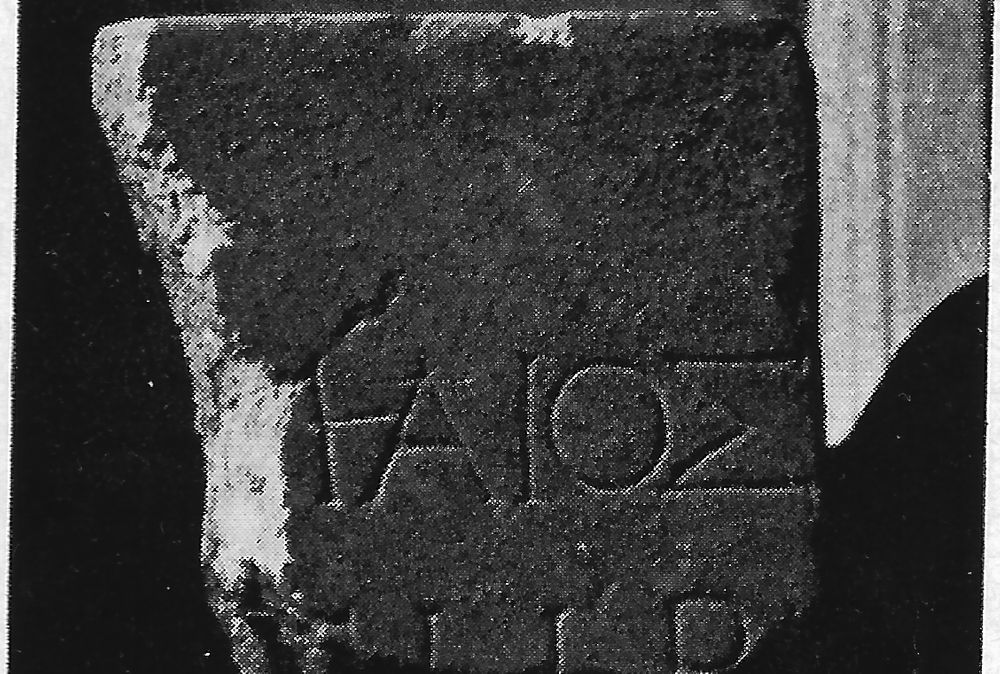EpiDoc XML:
IGCyr0645002
Trismegistos ID:
738337
Source description
Support: Two fragments of a white marble panel, later re-used on the reverse after a quarter turn for IRCyr2020 C.153; in their present condition, fragment a (inv. 301) is the upper right angle (w: 0.15 × h: 0.14 × d: 0.06); fragment b (inv. 189) is broken off at left and right and above (w: 0.15 × h: 0.115 × d: 0.06) and has a dowel hole full of metal where the lower edge is broken off at right. The tiny joint between both fragments is made sure by the inscription cut on the reverse.
Layout: Inscribed on the face, beginning at 0.075 from the upper edge and ending at 0.04 from the bottom. The spacement of letters varies at each line. There might be a vacat before the last word at line 3.
Letters: 0.028-0.03 carefully cut, with serifs; especially broad eta, kappa with long oblique bars, large omikron, non-slanting sigma.
Date: Probably between 116 and 107 BC (Rosamilia) (lettering, prosopography).
Findspot: Found before 1938 (at least for fragment a) at Cyrene ➚: exact findspot of both fragments unrecorded and anyhow related to the re-use.
Last recorded location: Cyrene Museum, 301 (a) and 189 (b). Fragment a seen by C. Dobias-Lalou in 1976 and fragment b in 1979, both in Shahat: Cyrene Museum.
Text constituted from: Transcription from stone (CDL).
Bibliography
Fragment a: Pugliese Carratelli – Oliverio 1961, p. 30, n. 10 (from †Oliverio's papers), fig. 19, whence SEG, 20.721, a; fragment b: not published before IGCyr 064500 ➚.
Cf. Rosamilia 2023, pp. 129-130.
Text
Apparatus
1: [Βασιλεὺς]: [---] Pugliese Carratelli – Oliverio 1961
2: [Σωτὴρ] Rosamilia 2023: [c. 7] IGCyr || [Ζη]νὶ Σ̣[ω]τ̣ῆρι̣: [Σω]τ̣ῆ̣ρ̣ι̣ Pugliese Carratelli – Oliverio 1961
3: [(vac. 4) τὸν?] (vac. 1) οἶκ[ον (vac. 4)] Rosamilia 2023: [c. 9](vac. 1) οἰκ[.. ? ..] IGCyr
French translation
[Le roi] Ptolémée [Sôtèr?] (scil. a consacré) à [Zeus?] Sôtèr [cet] édifice.
English translation
[King] Ptolemy [Soter?] (scil. dedicated) to [Zeus?] Soter [this?] building.
Italian translation
[Il re] Tolemeo [Sotere?] (scil. ha dedicato) a [Zeus?] Sotere [questo?] edificio.
Arabic translation
[الملك] بطليموس [سوتر؟] (ربما كلمة:خَصَّصَ) لِـ [زيوس؟] سوتر [هذا؟] المبنى
Commentary
In spite of the addition of a new fragment, this inscription remains fragmentary and its restoration remains hypothetical. However, Rosamilia 2023 offered a convincing improvement to the former reading.
At line 2, the dative ending in -νι allows to retain a divine epithet rather than a royal title for Soter. As a divine epithet, this is known for two deities in the Hellenistic period at Cyrene: 1) Zeus Soter became the patron of the dynasty in relation with Ptolemy Soter and his immediate followers; he was namely the leader of the theoi Soteres to whom a monumental altar was dedicated on the agora (IGCyr1000002); 2) Apollo is said Soter in the quite different context of the dedication made earlier in the port of Cyrene by thearoi travelling to Delphi (IGCyr0641002). Both divine names having the same ending at the dative, we choose Zeus on behalf of the mention of a Ptolemy. However the junction gained from the reverse in IRCyr2020 C.153 leaves a limited space for the royal titulature. The one which would fit best would be that of Ptolemy Philadelphus if it was Πτολεμαῖος Σωτήρων 'Ptolemy son of the Soteres', as at IGCyr0629002. However his reign seems too early on behalf of the script. As we put it in the 2017 edition, a more convincing possibility would be a short formulation of Ptolemy IX Soter II's titulature with only θεὸς Σωτήρ (shorter than at IGCyr0159002 and IGCyr0630002). This would fit perfectly the presumable date of the lettering. Rosamilia now suggests that θεός is not necessary. He also argues that that it was not necessary for the king to be present at Cyrene when offering a cult-place to his divine protector, which would be the meaning of οἶκος at line 3.
The provenance of the stone is not documented. It was probably found in the excavations of the sanctuary of Isis and Serapis of the acropolis, where it would have been brought for re-use from the neighbouring agora. In that area, there is indeed a Zeus' temple on the South side of Battos' street, which was rebuilt after the Jewish revolt of the second century AD. The supposed building offered at the end of the second century BC would have been its first stage.
CC BY-NC-SA 4.0 Deed Attribution-NonCommercial-ShareAlike 4.0 International License.
All citation, reuse or distribution of this work must contain a link back to DOI: https://doi.org/10.60760/unibo/igcyrgvcyr2 and the filename (IGCyr000000 or GVCyr000), as well as the year of consultation.


